engine MERCEDES-BENZ CL-Class 2012 C216 User Guide
[x] Cancel search | Manufacturer: MERCEDES-BENZ, Model Year: 2012, Model line: CL-Class, Model: MERCEDES-BENZ CL-Class 2012 C216Pages: 488, PDF Size: 21.88 MB
Page 24 of 488
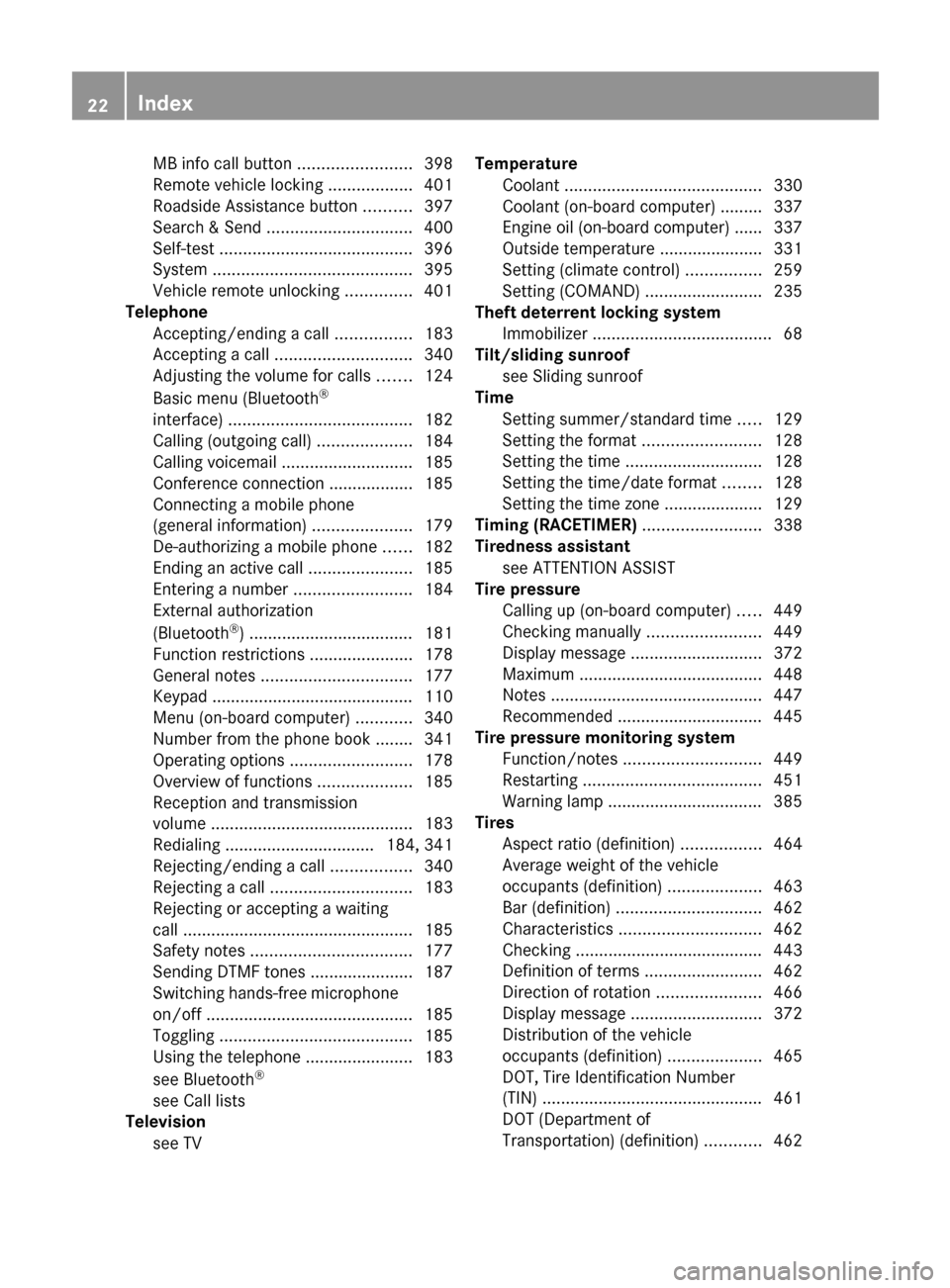
MB info call button ........................398
Remote vehicle locking ..................401
Roadside Assistance button ..........397
Search & Send ............................... 400
Self-test ......................................... 396
System .......................................... 395
Vehicle remote unlocking ..............401
Telephone
Accepting/ending a call ................183
Accepting a call ............................. 340
Adjusting the volume for calls .......124
Basic menu (Bluetooth ®
interface) ....................................... 182
Calling (outgoing call) ....................184
Calling voicemail ............................ 185
Conference connection .................. 185
Connecting a mobile phone
(general information) .....................179
De-authorizing a mobile phone ......182
Ending an active call ......................185
Entering a number .........................184
External authorization
(Bluetooth ®
) ................................... 181
Function restrictions ......................178
General notes ................................ 177
Keypad ........................................... 110
Menu (on-board computer) ............340
Number from the phone book ........ 341
Operating options ..........................178
Overview of functions ....................185
Reception and transmission
volume ........................................... 183
Redialing ................................ 184, 341
Rejecting/ending a call .................340
Rejecting a call .............................. 183
Rejecting or accepting a waiting
call ................................................. 185
Safety notes .................................. 177
Sending DTMF tones ...................... 187
Switching hands-free microphone
on/off ............................................ 185
Toggling ......................................... 185
Using the telephone ....................... 183
see Bluetooth ®
see Call lists
Television
see TV Temperature
Coolant .......................................... 330
Coolant (on-board computer) ......... 337
Engine oil (on-board computer) ...... 337
Outside temperature ...................... 331
Setting (climate control) ................259
Setting (COMAND) .........................235
Theft deterrent locking system
Immobilizer ...................................... 68
Tilt/sliding sunroof
see Sliding sunroof
Time
Setting summer/standard time .....129
Setting the format .........................128
Setting the time ............................. 128
Setting the time/date format ........128
Setting the time zone ..................... 129
Timing (RACETIMER) ......................... 338
Tiredness assistant see ATTENTION ASSIST
Tire pressure
Calling up (on-board computer) .....449
Checking manually ........................449
Display message ............................ 372
Maximum ....................................... 448
Notes ............................................. 447
Recommended ............................... 445
Tire pressure monitoring system
Function/notes ............................. 449
Restarting ...................................... 451
Warning lamp ................................. 385
Tires
Aspect ratio (definition) .................464
Average weight of the vehicle
occupants (definition) ....................463
Bar (definition) ............................... 462
Characteristics .............................. 462
Checking ........................................ 443
Definition of terms .........................462
Direction of rotation ......................466
Display message ............................ 372
Distribution of the vehicle
occupants (definition) ....................465
DOT, Tire Identification Number
(TIN) ............................................... 461
DOT (Department of
Transportation) (definition) ............46222Index
Page 25 of 488
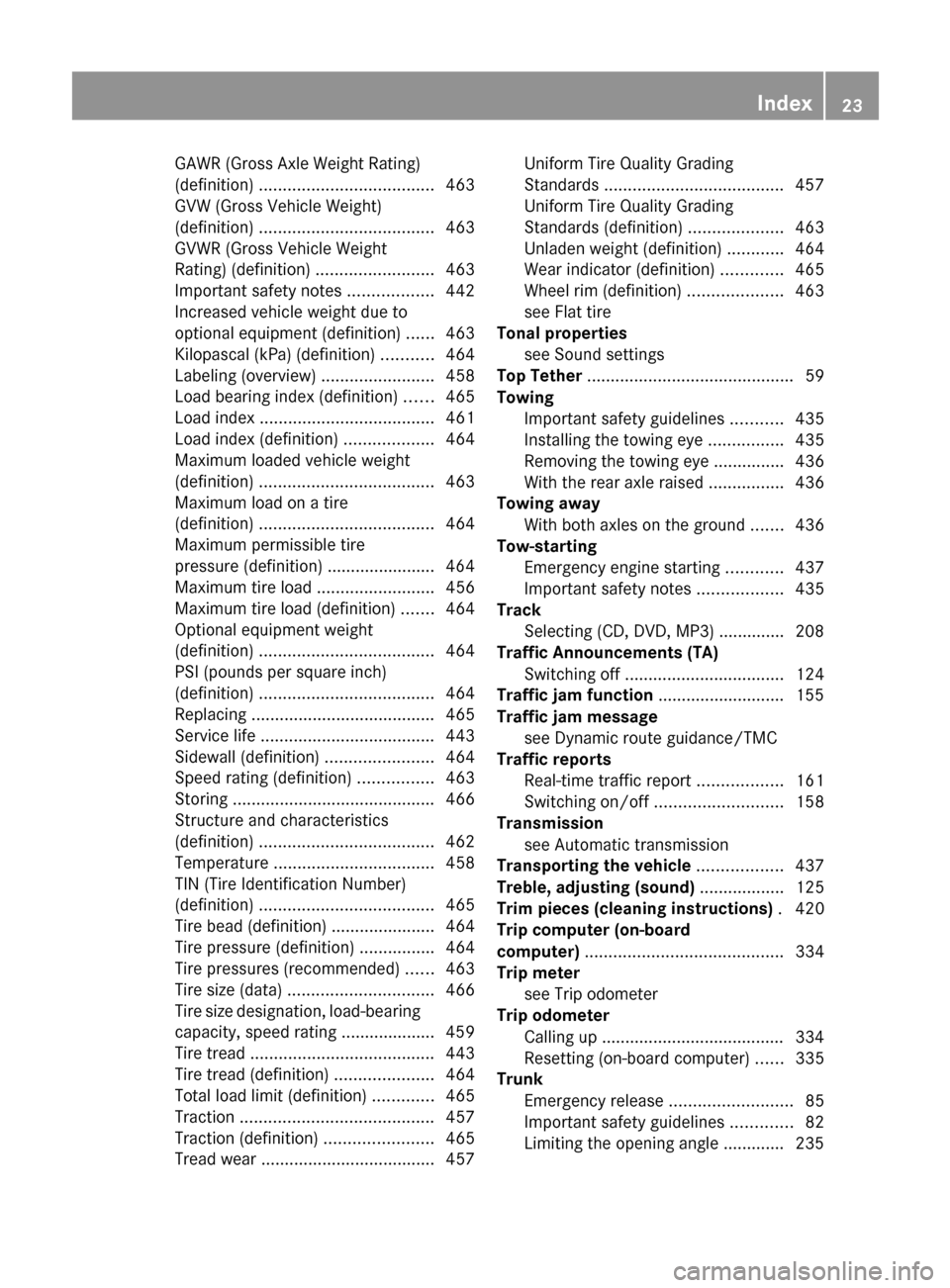
GAWR (Gross Axle Weight Rating)
(definition) ..................................... 463
GVW (Gross Vehicle Weight)
(definition) ..................................... 463
GVWR (Gross Vehicle Weight
Rating) (definition) .........................463
Important safety notes ..................442
Increased vehicle weight due to
optional equipment (definition) ......463
Kilopascal (kPa) (definition) ...........464
Labeling (overview) ........................458
Load bearing index (definition) ......465
Load index ..................................... 461
Load index (definition) ...................464
Maximum loaded vehicle weight
(definition) ..................................... 463
Maximum load on a tire
(definition) ..................................... 464
Maximum permissible tire
pressure (definition) ....................... 464
Maximum tire load .........................456
Maximum tire load (definition) .......464
Optional equipment weight
(definition) ..................................... 464
PSI (pounds per square inch)
(definition) ..................................... 464
Replacing ....................................... 465
Service life ..................................... 443
Sidewall (definition) .......................464
Speed rating (definition) ................463
Storing ........................................... 466
Structure and characteristics
(definition) ..................................... 462
Temperature .................................. 458
TIN (Tire Identification Number)
(definition) ..................................... 465
Tire bead (definition) ......................464
Tire pressure (definition) ................464
Tire pressures (recommended) ......463
Tire size (data) ............................... 466
Tire size designation, load-bearing
capacity, speed rating .................... 459
Tire tread ....................................... 443
Tire tread (definition) .....................464
Total load limit (definition) .............465
Traction ......................................... 457
Traction (definition) .......................465
Tread wear ..................................... 457Uniform Tire Quality Grading
Standards ...................................... 457
Uniform Tire Quality Grading
Standards (definition) ....................463
Unladen weight (definition) ............464
Wear indicator (definition) .............465
Wheel rim (definition) ....................463
see Flat tire
Tonal properties
see Sound settings
Top Tether ............................................ 59
Towing Important safety guidelines ...........435
Installing the towing eye ................435
Removing the towing eye ...............436
With the rear axle raised ................436
Towing away
With both axles on the ground .......436
Tow-starting
Emergency engine starting ............437
Important safety notes ..................435
Track
Selecting (CD, DVD, MP3) .............. 208
Traffic Announcements (TA)
Switching off .................................. 124
Traffic jam function ........................... 155
Traffic jam message see Dynamic route guidance/TMC
Traffic reports
Real-time traffic report ..................161
Switching on/off ........................... 158
Transmission
see Automatic transmission
Transporting the vehicle .................. 437
Treble, adjusting (sound) .................. 125
Trim pieces (cleaning instructions) . 420
Trip computer (on-board
computer) .......................................... 334
Trip meter see Trip odometer
Trip odometer
Calling up ....................................... 334
Resetting (on-board computer) ......335
Trunk
Emergency release ..........................85
Important safety guidelines .............82
Limiting the opening angle ............. 235Index23
Page 27 of 488
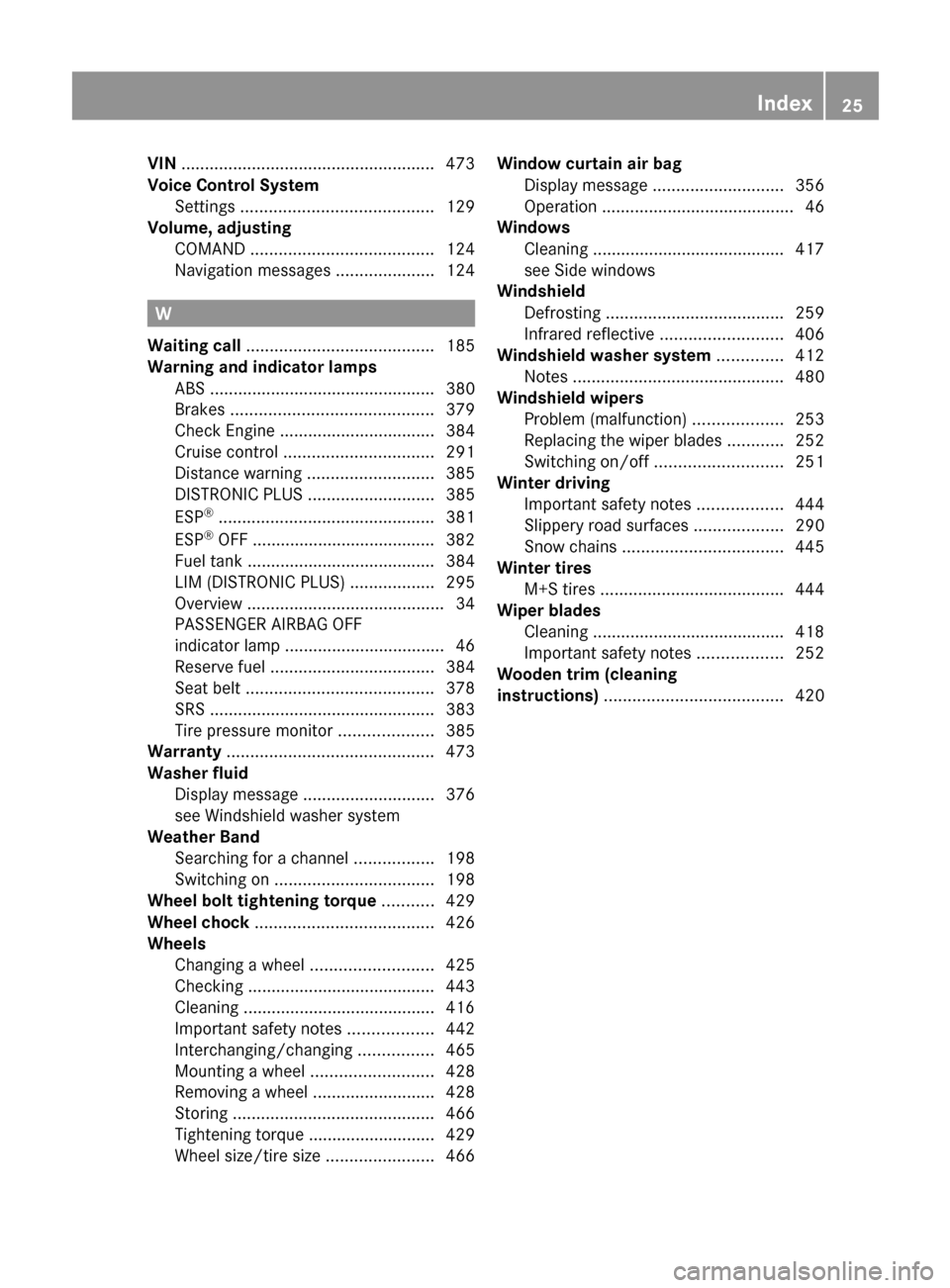
VIN ...................................................... 473
Voice Control System Settings ......................................... 129
Volume, adjusting
COMAND ....................................... 124
Navigation messages .....................124
W
Waiting call ........................................ 185
Warning and indicator lamps ABS ................................................ 380
Brakes ........................................... 379
Check Engine ................................. 384
Cruise control ................................ 291
Distance warning ........................... 385
DISTRONIC PLUS ........................... 385
ESP ®
.............................................. 381
ESP ®
OFF ....................................... 382
Fuel tank ........................................ 384
LIM (DISTRONIC PLUS) ..................295
Overview .......................................... 34
PASSENGER AIRBAG OFF
indicator lamp .................................. 46
Reserve fuel ................................... 384
Seat belt ........................................ 378
SRS ................................................ 383
Tire pressure monitor ....................385
Warranty ............................................ 473
Washer fluid Display message ............................ 376
see Windshield washer system
Weather Band
Searching for a channel .................198
Switching on .................................. 198
Wheel bolt tightening torque ........... 429
Wheel chock ...................................... 426
Wheels Changing a wheel .......................... 425
Checking ........................................ 443
Cleaning ......................................... 416
Important safety notes ..................442
Interchanging/changing ................465
Mounting a wheel .......................... 428
Removing a wheel ..........................428
Storing ........................................... 466
Tightening torque ........................... 429
Wheel size/tire size .......................466
Window curtain air bag
Display message ............................ 356
Operation ......................................... 46
Windows
Cleaning ......................................... 417
see Side windows
Windshield
Defrosting ...................................... 259
Infrared reflective .......................... 406
Windshield washer system .............. 412
Notes ............................................. 480
Windshield wipers
Problem (malfunction) ...................253
Replacing the wiper blades ............252
Switching on/off ........................... 251
Winter driving
Important safety notes ..................444
Slippery road surfaces ...................290
Snow chains .................................. 445
Winter tires
M+S tires ....................................... 444
Wiper blades
Cleaning ......................................... 418
Important safety notes ..................252
Wooden trim (cleaning
instructions) ...................................... 420Index25
Page 30 of 488

If you bought this vehicle used, be sure to
send in the "Notice of Purchase of Used Car"
found in the Service and Warranty
Information Booklet, or call the Mercedes-
Benz Customer Assistance Center (in the
USA) at
1-800-FOR-MERCedes(1-800-367-6372) or
Customer Service (in Canada) at
1-800-387-0100.
Vehicle operation outside the USA
and Canada
If you plan to operate your vehicle in foreign
countries, please be aware that:
R service facilities or replacement parts may
not be readily available.
R unleaded fuel for vehicles with a catalytic
converter may not be available. Leaded fuel
may cause damage to the catalytic
converter.
R the fuel may have a considerably lower
octane rating. Unsuitable fuel can cause
engine damage.
Some Mercedes-Benz models are available
for delivery in Europe through our European
Delivery Program. For details, consult an
authorized Mercedes-Benz Center or write to
one of the following addresses.
In the USA
Mercedes-Benz USA, LLC
European Delivery Department
One Mercedes Drive
Montvale, NJ 07645-0350
In Canada
Mercedes-Benz Canada, Inc.
European Delivery Department
98 Vanderhoof Avenue
Toronto, Ontario M4G 4C9
Operating safety
Safety notes
GWARNING
Work improperly carried out on electronic
components and associated software could
cause them to cease functioning. Because the
vehicle's electronic components are
interconnected, any modifications made may
produce an undesired effect on other
systems. Electronic malfunctions could
seriously impair the operating safety of your
vehicle.
Contact an authorized Mercedes-Benz Center
for repairs or modifications to electronic
components.
Other improper work or modifications on the
vehicle could also have a negative impact on
the operating safety of the vehicle.
Some safety systems only function when the
engine is running. You should therefore never
turn off the engine while driving.
GWARNING
Heavy blows against the vehicle underbody or
tires/wheels may cause serious damage and
impair the operating safety of your vehicle.
Such blows can be caused, for example, by
running over an obstacle, road debris or a
pothole.
If you feel a sudden significant vibration or
ride disturbance, or you suspect that damage
to your vehicle has occurred:
R turn on your hazard warning flashers.
R slow down carefully.
R drive with caution to an area which is a safe
distance from the road.
Inspect the vehicle underbody and tires/
wheels for possible damage. If the vehicle
appears unsafe, have it towed to the nearest
authorized Mercedes-Benz Center or other
qualified maintenance or repair facility for
further inspection or repairs.
28Introduction
Page 36 of 488
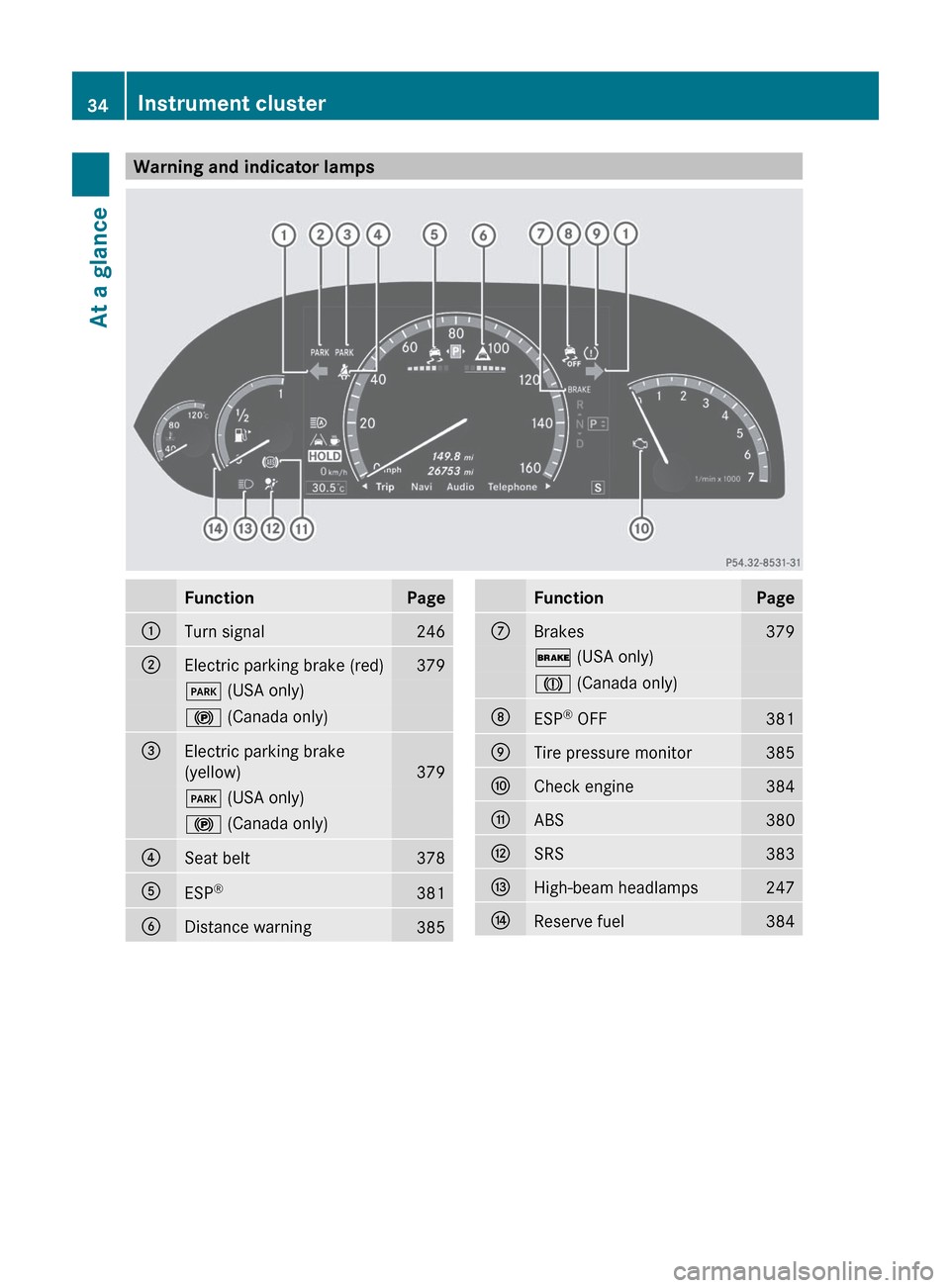
Warning and indicator lampsFunctionPage:Turn signal246;Electric parking brake (red)379F (USA only)! (Canada only)=Electric parking brake
(yellow)
379
F (USA only)! (Canada only)?Seat belt378AESP®381BDistance warning385FunctionPageCBrakes379$
(USA only)J (Canada only)DESP®
OFF381ETire pressure monitor385FCheck engine384GABS380HSRS383IHigh-beam headlamps247JReserve fuel38434Instrument clusterAt a glance
Page 42 of 488
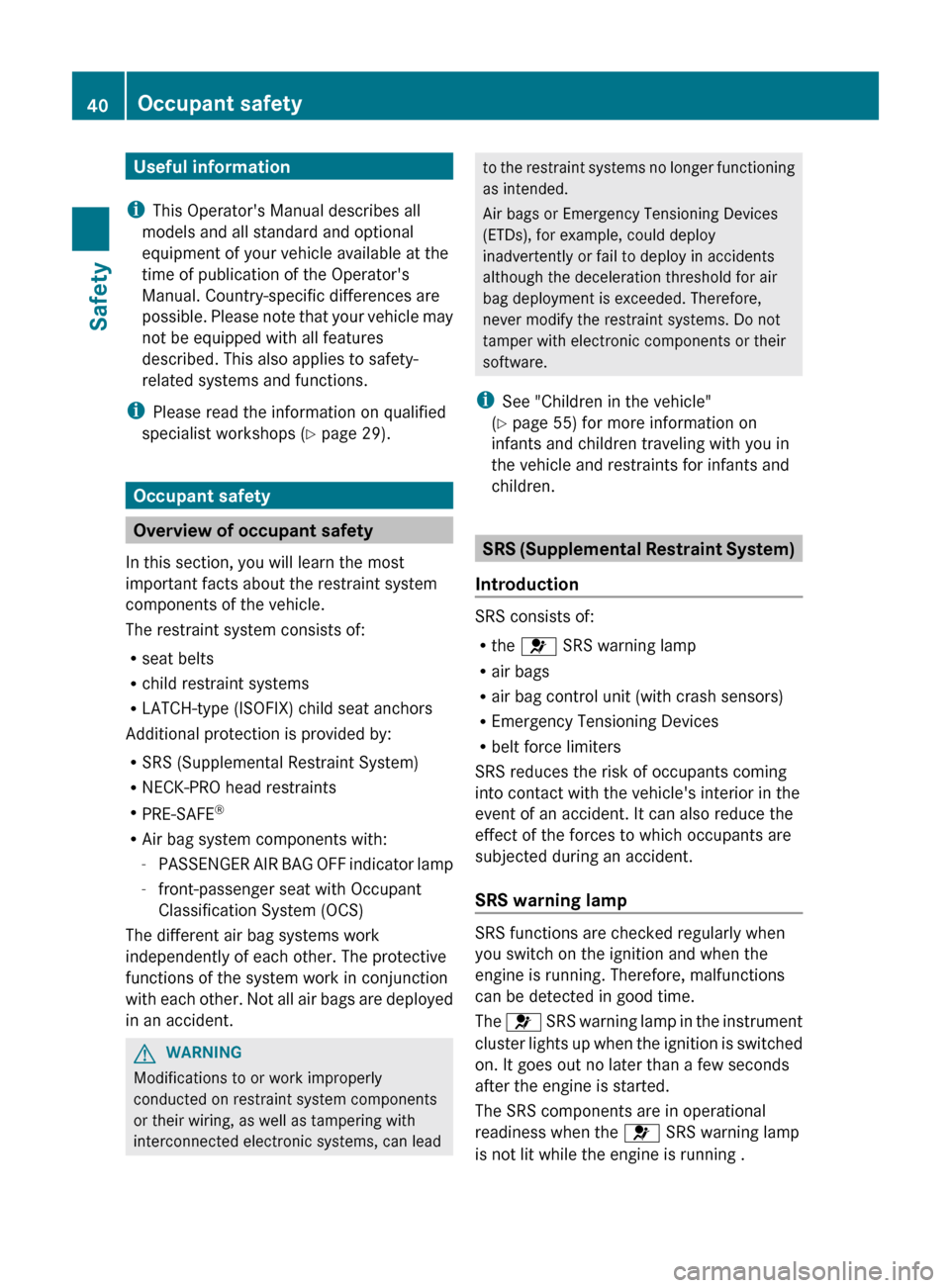
Useful information
i This Operator's Manual describes all
models and all standard and optional
equipment of your vehicle available at the
time of publication of the Operator's
Manual. Country-specific differences are
possible. Please note that your vehicle may
not be equipped with all features
described. This also applies to safety-
related systems and functions.
i Please read the information on qualified
specialist workshops ( Y page 29).
Occupant safety
Overview of occupant safety
In this section, you will learn the most
important facts about the restraint system
components of the vehicle.
The restraint system consists of:
R seat belts
R child restraint systems
R LATCH-type (ISOFIX) child seat anchors
Additional protection is provided by:
R SRS (Supplemental Restraint System)
R NECK-PRO head restraints
R PRE-SAFE ®
R Air bag system components with:
- PASSENGER AIR BAG OFF indicator lamp
- front-passenger seat with Occupant
Classification System (OCS)
The different air bag systems work
independently of each other. The protective
functions of the system work in conjunction
with each other. Not all air bags are deployed
in an accident.
GWARNING
Modifications to or work improperly
conducted on restraint system components
or their wiring, as well as tampering with
interconnected electronic systems, can lead
to the restraint systems no longer functioning
as intended.
Air bags or Emergency Tensioning Devices
(ETDs), for example, could deploy
inadvertently or fail to deploy in accidents
although the deceleration threshold for air
bag deployment is exceeded. Therefore,
never modify the restraint systems. Do not
tamper with electronic components or their
software.
i See "Children in the vehicle"
( Y page 55) for more information on
infants and children traveling with you in
the vehicle and restraints for infants and
children.
SRS (Supplemental Restraint System)
Introduction
SRS consists of:
R the 6 SRS warning lamp
R air bags
R air bag control unit (with crash sensors)
R Emergency Tensioning Devices
R belt force limiters
SRS reduces the risk of occupants coming
into contact with the vehicle's interior in the
event of an accident. It can also reduce the
effect of the forces to which occupants are
subjected during an accident.
SRS warning lamp
SRS functions are checked regularly when
you switch on the ignition and when the
engine is running. Therefore, malfunctions
can be detected in good time.
The 6 SRS warning lamp in the instrument
cluster lights up when the ignition is switched
on. It goes out no later than a few seconds
after the engine is started.
The SRS components are in operational
readiness when the 6 SRS warning lamp
is not lit while the engine is running .
40Occupant safetySafety
Page 43 of 488
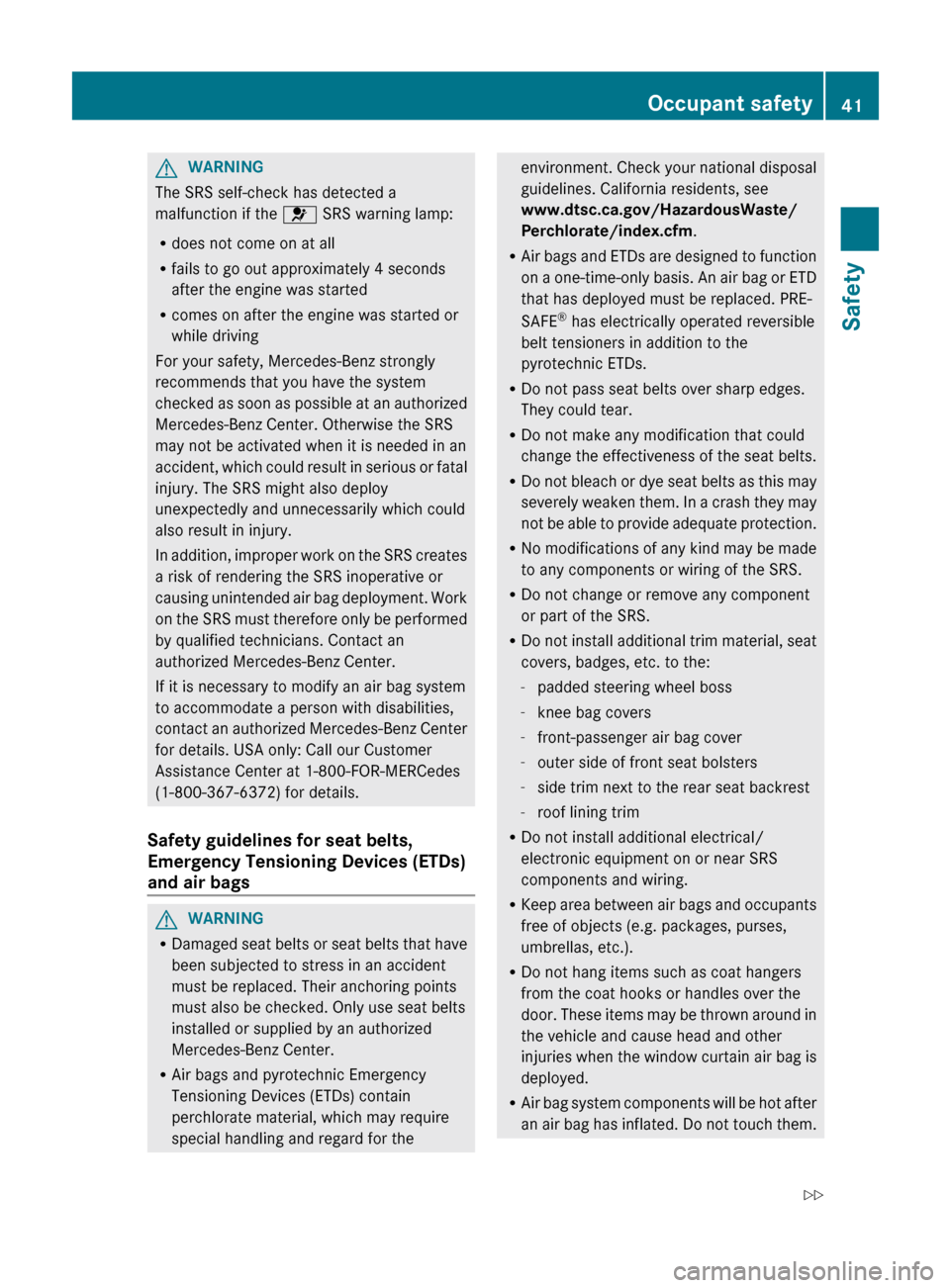
GWARNING
The SRS self-check has detected a
malfunction if the 6 SRS warning lamp:
R does not come on at all
R fails to go out approximately 4 seconds
after the engine was started
R comes on after the engine was started or
while driving
For your safety, Mercedes-Benz strongly
recommends that you have the system
checked as soon as possible at an authorized
Mercedes-Benz Center. Otherwise the SRS
may not be activated when it is needed in an
accident, which could result in serious or fatal
injury. The SRS might also deploy
unexpectedly and unnecessarily which could
also result in injury.
In addition, improper work on the SRS creates
a risk of rendering the SRS inoperative or
causing unintended air bag deployment. Work
on the SRS must therefore only be performed
by qualified technicians. Contact an
authorized Mercedes-Benz Center.
If it is necessary to modify an air bag system
to accommodate a person with disabilities,
contact an authorized Mercedes-Benz Center
for details. USA only: Call our Customer
Assistance Center at 1-800-FOR-MERCedes
(1-800-367-6372) for details.
Safety guidelines for seat belts,
Emergency Tensioning Devices (ETDs)
and air bags
GWARNING
R Damaged seat belts or seat belts that have
been subjected to stress in an accident
must be replaced. Their anchoring points
must also be checked. Only use seat belts
installed or supplied by an authorized
Mercedes-Benz Center.
R Air bags and pyrotechnic Emergency
Tensioning Devices (ETDs) contain
perchlorate material, which may require
special handling and regard for the
environment. Check your national disposal
guidelines. California residents, see
www.dtsc.ca.gov/HazardousWaste/
Perchlorate/index.cfm .
R Air bags and ETDs are designed to function
on a one-time-only basis. An air bag or ETD
that has deployed must be replaced. PRE-
SAFE ®
has electrically operated reversible
belt tensioners in addition to the
pyrotechnic ETDs.
R Do not pass seat belts over sharp edges.
They could tear.
R Do not make any modification that could
change the effectiveness of the seat belts.
R Do not bleach or dye seat belts as this may
severely weaken them. In a crash they may
not be able to provide adequate protection.
R No modifications of any kind may be made
to any components or wiring of the SRS.
R Do not change or remove any component
or part of the SRS.
R Do not install additional trim material, seat
covers, badges, etc. to the:
- padded steering wheel boss
- knee bag covers
- front-passenger air bag cover
- outer side of front seat bolsters
- side trim next to the rear seat backrest
- roof lining trim
R Do not install additional electrical/
electronic equipment on or near SRS
components and wiring.
R Keep area between air bags and occupants
free of objects (e.g. packages, purses,
umbrellas, etc.).
R Do not hang items such as coat hangers
from the coat hooks or handles over the
door. These items may be thrown around in
the vehicle and cause head and other
injuries when the window curtain air bag is
deployed.
R Air bag system components will be hot after
an air bag has inflated. Do not touch them.Occupant safety41SafetyZ
Page 49 of 488
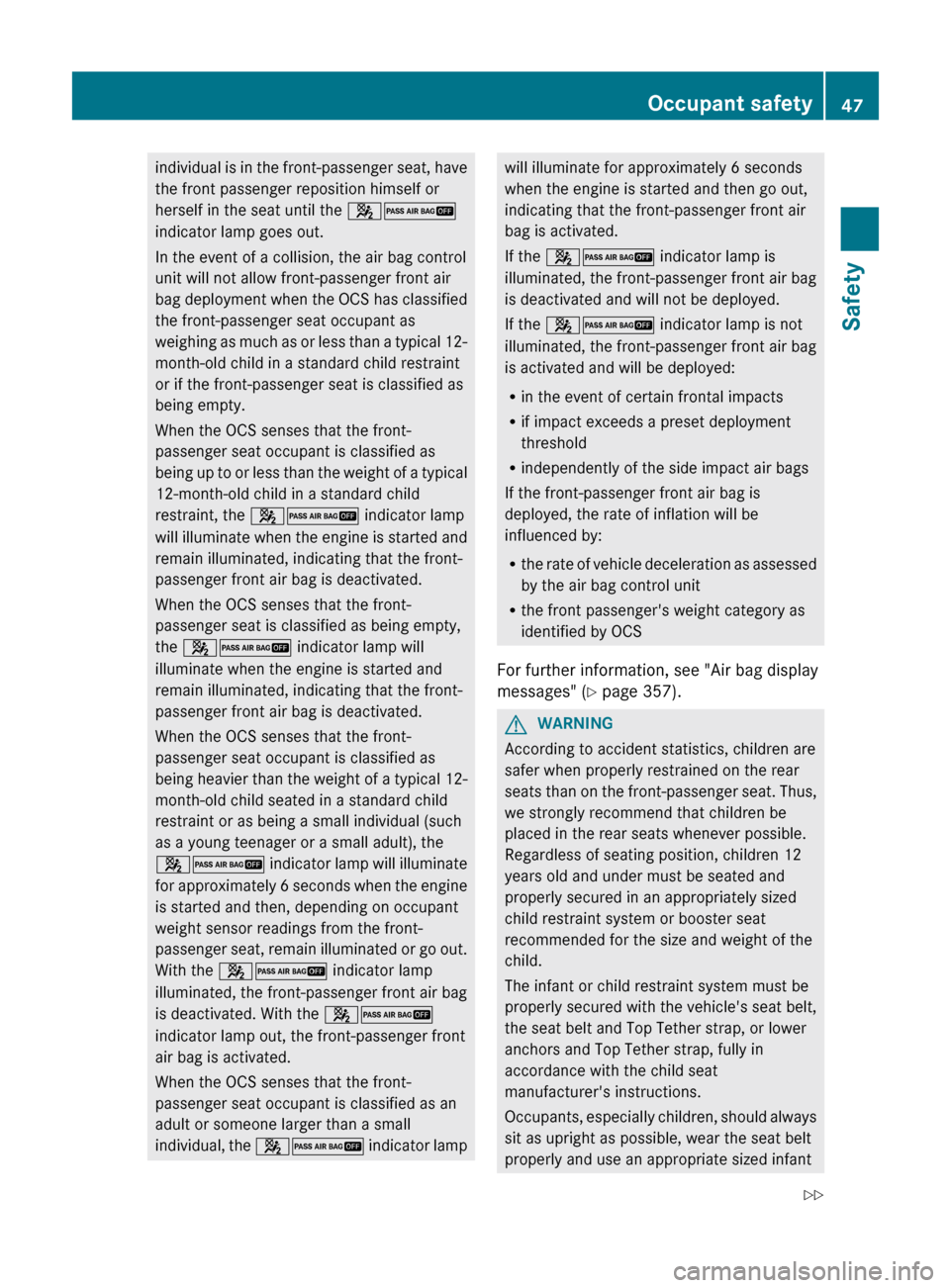
individual is in the front-passenger seat, have
the front passenger reposition himself or
herself in the seat until the 42
indicator lamp goes out.
In the event of a collision, the air bag control
unit will not allow front-passenger front air
bag deployment when the OCS has classified
the front-passenger seat occupant as
weighing as much as or less than a typical 12-
month-old child in a standard child restraint
or if the front-passenger seat is classified as
being empty.
When the OCS senses that the front-
passenger seat occupant is classified as
being up to or less than the weight of a typical
12-month-old child in a standard child
restraint, the 42 indicator lamp
will illuminate when the engine is started and
remain illuminated, indicating that the front-
passenger front air bag is deactivated.
When the OCS senses that the front-
passenger seat is classified as being empty,
the 42 indicator lamp will
illuminate when the engine is started and
remain illuminated, indicating that the front-
passenger front air bag is deactivated.
When the OCS senses that the front-
passenger seat occupant is classified as
being heavier than the weight of a typical 12-
month-old child seated in a standard child
restraint or as being a small individual (such
as a young teenager or a small adult), the
42 indicator lamp will illuminate
for approximately 6 seconds when the engine
is started and then, depending on occupant
weight sensor readings from the front-
passenger seat, remain illuminated or go out.
With the 42 indicator lamp
illuminated, the front-passenger front air bag
is deactivated. With the 42
indicator lamp out, the front-passenger front
air bag is activated.
When the OCS senses that the front-
passenger seat occupant is classified as an
adult or someone larger than a small
individual, the 42 indicator lampwill illuminate for approximately 6 seconds
when the engine is started and then go out,
indicating that the front-passenger front air
bag is activated.
If the 42 indicator lamp is
illuminated, the front-passenger front air bag
is deactivated and will not be deployed.
If the 42 indicator lamp is not
illuminated, the front-passenger front air bag
is activated and will be deployed:
R in the event of certain frontal impacts
R if impact exceeds a preset deployment
threshold
R independently of the side impact air bags
If the front-passenger front air bag is
deployed, the rate of inflation will be
influenced by:
R the rate of vehicle deceleration as assessed
by the air bag control unit
R the front passenger's weight category as
identified by OCS
For further information, see "Air bag display
messages" ( Y page 357).GWARNING
According to accident statistics, children are
safer when properly restrained on the rear
seats than on the front-passenger seat. Thus,
we strongly recommend that children be
placed in the rear seats whenever possible.
Regardless of seating position, children 12
years old and under must be seated and
properly secured in an appropriately sized
child restraint system or booster seat
recommended for the size and weight of the
child.
The infant or child restraint system must be
properly secured with the vehicle's seat belt,
the seat belt and Top Tether strap, or lower
anchors and Top Tether strap, fully in
accordance with the child seat
manufacturer's instructions.
Occupants, especially children, should always
sit as upright as possible, wear the seat belt
properly and use an appropriate sized infant
Occupant safety47SafetyZ
Page 56 of 488

XAdjust the seat and move the backrest to
an almost vertical position ( Y page 92).XPull the seat belt smoothly through belt
sash guide :.XWithout twisting it, guide the shoulder
section of the seat belt across the middle
of your shoulder and the lap section across
your hips.XEngage belt tongue ; in buckle =.XIf necessary, pull upwards on the shoulder
section of the seat belt to tighten the belt
across your body.
All seat belts except the driver's seat belt are
equipped with a special seat belt retractor to
securely fasten child restraint systems in the
vehicle. For further information on special
seat belt retractors, see ( Y page 57).
For more information about releasing the seat
belt with release button ?, see "Releasing
seat belts" ( Y page 54).
Releasing seat belts
XPress release button ?(Y page 53) and
guide belt tongue ; back towards belt
sash guide :.
!
Make sure that the seat belt is fully rolled
up. Otherwise, the seat belt or belt tongue
will be trapped in the door or in the seat
mechanism. This could damage the door,
the door trim panel and the seat belt.
Damaged seat belts can no longer fulfill
their protective function and must be
replaced. Consult an authorized Mercedes-
Benz Center.
Belt warning for the driver and front
passenger
Regardless of whether the driver and front
passenger have fastened their seat belts
already, the 7 seat belt warning lamp
lights up for 6 seconds after every engine
start. It then goes out if the driver and the
front passenger have fastened their seat
belts.
If the driver's seat belt is not fastened after
the engine is started, an additional warning
tone will sound. The warning tone goes out
after approximately six seconds or once the
driver's seat belt is fastened.
If the driver or front passenger have not
fastened their seat belt after 6 seconds and
the doors are closed, the 7 seat belt
warning lamp lights up.
R until the driver or the front passenger have
fastened their seat belts
R if a vehicle speed of 15 mph(25 km/h) is
exceeded once, a warning tone with
increasing intensity sounds additionally for
a maximum of 60 seconds or until the driver
or front passenger have fastened their seat
belts.
If the driver or front passenger undo their seat
belts during the journey, the 7 seat belt
warning lamp lights up and the warning tone
sounds again.
The warning tone ceases even if the driver or
front passenger have still not fastened their
seat belt after 60 seconds. The 7 seat belt
warning lamp stops flashing but continues to
be lit.
Once the vehicle is stationary, the warning
tone is reactivated and the 7 seat belt
warning lamp starts to flash again if the
vehicle speed exceeds 15 mph(25 km/h)
once.
The 7 seat belt warning lamp only goes
out if:
R both the driver and the front passenger
have fastened their seat belts.
or
R the vehicle is stationary and a door is open.
i For more information on the 7 seat
belt warning lamp, see "Warning and
indicator lamps in the instrument cluster,
seat belt" ( Y page 378).54Occupant safetySafety
Page 64 of 488
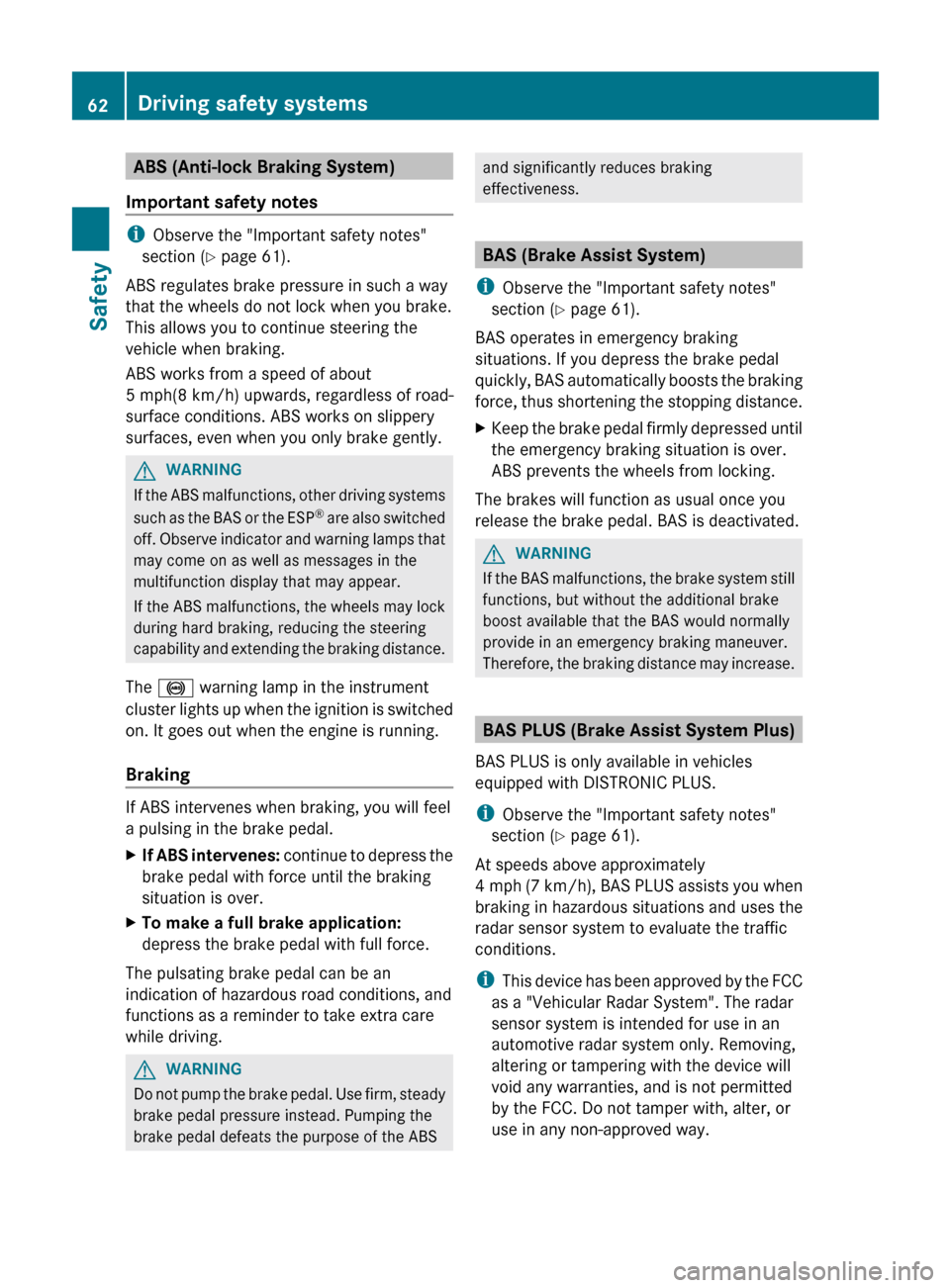
ABS (Anti-lock Braking System)
Important safety notes
i Observe the "Important safety notes"
section ( Y page 61).
ABS regulates brake pressure in such a way
that the wheels do not lock when you brake.
This allows you to continue steering the
vehicle when braking.
ABS works from a speed of about
5 mph(8 km/h) upwards, regardless of road-
surface conditions. ABS works on slippery
surfaces, even when you only brake gently.
GWARNING
If the ABS malfunctions, other driving systems
such as the BAS or the ESP ®
are also switched
off. Observe indicator and warning lamps that
may come on as well as messages in the
multifunction display that may appear.
If the ABS malfunctions, the wheels may lock
during hard braking, reducing the steering
capability and extending the braking distance.
The ! warning lamp in the instrument
cluster lights up when the ignition is switched
on. It goes out when the engine is running.
Braking
If ABS intervenes when braking, you will feel
a pulsing in the brake pedal.
XIf ABS intervenes: continue to depress the
brake pedal with force until the braking
situation is over.XTo make a full brake application:
depress the brake pedal with full force.
The pulsating brake pedal can be an
indication of hazardous road conditions, and
functions as a reminder to take extra care
while driving.
GWARNING
Do not pump the brake pedal. Use firm, steady
brake pedal pressure instead. Pumping the
brake pedal defeats the purpose of the ABS
and significantly reduces braking
effectiveness.
BAS (Brake Assist System)
i Observe the "Important safety notes"
section ( Y page 61).
BAS operates in emergency braking
situations. If you depress the brake pedal
quickly, BAS automatically boosts the braking
force, thus shortening the stopping distance.
XKeep the brake pedal firmly depressed until
the emergency braking situation is over.
ABS prevents the wheels from locking.
The brakes will function as usual once you
release the brake pedal. BAS is deactivated.
GWARNING
If the BAS malfunctions, the brake system still
functions, but without the additional brake
boost available that the BAS would normally
provide in an emergency braking maneuver.
Therefore, the braking distance may increase.
BAS PLUS (Brake Assist System Plus)
BAS PLUS is only available in vehicles
equipped with DISTRONIC PLUS.
i Observe the "Important safety notes"
section ( Y page 61).
At speeds above approximately
4 mph (7 km/h), BAS PLUS assists you when
braking in hazardous situations and uses the
radar sensor system to evaluate the traffic
conditions.
i This device has been approved by the FCC
as a "Vehicular Radar System". The radar
sensor system is intended for use in an
automotive radar system only. Removing,
altering or tampering with the device will
void any warranties, and is not permitted
by the FCC. Do not tamper with, alter, or
use in any non-approved way.
62Driving safety systemsSafety